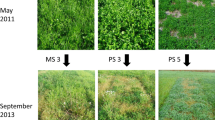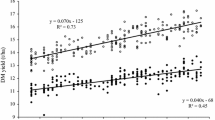Abstract
Herbage yield trials are necessary to test if candidate varieties are well suited for organic conditions. In order to elucidate a particular suitability for organic conditions, we run such trials in parallel under both organic and conventional conditions. Here, we report on second and third year results of the sowings 2004 and 2005. These trials are part of a targeted breeding programme for organic conditions. Irregular colonisation of pure grass plots with adventitious plants, in particular white clover, was recognized as a major constraint to the quality of the results obtained under organic conditions. The coefficients of variance in dry matter yield almost doubled when compared to conventional trials, and significant differences in annual yield among varieties were rare. However, when herbage yield was corrected for the estimated fraction of adventitious plant colonization at each cut, the number of instances with statistically significant differences for annual yield among varieties increased more than fourfold. Dry matter yields under organic and conventional conditions were significantly and positively correlated. However, analysis of variance showed a significant culture type by variety interaction for annual dry matter yield in 12 out of 24 trials. When diploid and tetraploid varieties of the same Lolium species were tested in one common trial, only tetraploid varieties were identified as being particularly well suited for organic conditions, while in these trials, the great majority of apparently poorly suited varieties were diploid. This suggests that breeding tetraploid Lolium varieties is promising when aiming at a favourable response to organic agriculture.

Similar content being viewed by others
References
Baert J, Van Eckeren N, Ghesquiere A (2007) Breeding fodder grass and clover for low input/organic conditions in N.W. Europe. In: Rosellini D, Veronesi F (eds) Breeding and seed production for conventional and organic agriculture. Proceedings XXVI Meeting of the EUCARPIA Fodder Crops and Amenity Grasses Section, Perugia, 3–7 September 2006. Cornicchie grafiche, Perugia, pp 31–37
Boller BC, Nösberger J (1988) Influence of dissimilarities in temporal and spatial N-uptake patterns on 15N-based estimates of fixation and transfer of N in ryegrass-clover mixtures. Plant Soil 112:167–175
Boller B, Tanner P, Schubiger FX (2007) Discriminatory power of herbage yield trials under organic conditions. In: Rosellini D, Veronesi F (eds) Breeding and seed production for conventional and organic agriculture. Proceedings XXVI Meeting of the EUCARPIA Fodder Crops and Amenity Grasses Section, Perugia, 3–7 September 2006. Cornicchie grafiche, Perugia, pp 60–64
FiBl (2007) Sortenempfehlungen Brotgetreide für die Ernte 2008. Forschungsinstitut für biologischen Landbau, Frick. Available via https://www.fibl.org/shop/artikel/sl-1034-biogetreide.html
Gilliland TJ, Barrett PD, Mann RL et al (2002) Canopy morphology and nutritional quality traits as potential grazing value indicators for Lolium perenne varieties. J Agr Sci 139:257–273 Part 3
Gylfadottir T, Helgadottir A, Hogh-Jensen H (2007) Consequences of including adapted white clover in northern European grassland: transfer and deposition of nitrogen. Plant Soil 297:93–104
Kempf H (2003) Weizenzüchtung für den ökologischen Landbau – Züchtung und Zulassung der Sorte Ökostar in Deutschland. In: Bericht über die Arbeitstagung 2002 der Vereinigung der Pflanzenzüchter und Saatgutkaufleute Österreichs, BAL, Gumpenstein, pp 64–70
Kunz P, Becker K, Buchmann M et al (2005) Die Züchtung von Top-Qualitätsweizen für den Biologischen Landbau. In: Tagungsband der 56. Arbeitstagung der Vereinigung der Pflanzenzüchter und Saatgutkaufleute Österreichs, BAL, Raumberg-Gumpenstein, pp 3–8
Laidlaw AS (2004) Effect of heading date of perennial ryegrass cultivars on tillering and tiller development in spring and summer. Grass For Sci 59:240–249
Phillips SL, Wolfe MS (2005) Evolutionary plant breeding for low input systems. J Agr Sci 143:245–254 Part 4
Schwärzel R, Levy L, Menzi M et al (2006) Winterweizensorten im biologischen und extensiven Anbau. Agrarforschung 13:68–73
Smith KF, Simpson RJ, Culvenor RA et al (2001) The effects of ploidy and a phenotype conferring a high water-soluble carbohydrate concentration on carbohydrate accumulation, nutritive value and morphology of perennial ryegrass (Lolium perenne L.). J Agr Sci 136:65–74 Part 1
Suter D, Lehmann J, Briner H-U et al (2003) Sortenversuche unter Anbaubedingungen des biologischen Landbaus: Italienisches Raigras und Bastard-Raigras. Schriftenreihe der FAL 45:19–23
Wyss E, Lammerts van Bueren E, Hulscher M et al (2001) Techniken der Pflanzenzüchtung, Eine Einschätzung für die ökologische Pflanzenzüchtung. FiBL dossier Nr. 2, Forschunginstitut für biologischen Landbau, Frick, 23 pp
Author information
Authors and Affiliations
Corresponding author
Rights and permissions
About this article
Cite this article
Boller, B., Tanner, P. & Schubiger, F.X. Breeding forage grasses for organic conditions. Euphytica 163, 459–467 (2008). https://doi.org/10.1007/s10681-008-9668-7
Received:
Accepted:
Published:
Issue Date:
DOI: https://doi.org/10.1007/s10681-008-9668-7




